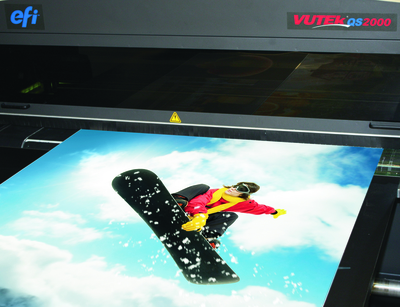Perspex Distribution prides itself on its expertise in the rigid substrates market, with a product range that incorporates much more than its core Perspex sheets.
Passionate about Perspex is an alliterative phrase that easily rolls off the tongue, but at Perspex Distribution it is a fact of life. The company even holds a fun annual quiz about its products among staff at its four UK branches, with those at Weybridge in Surrey currently holding the internal bragging rights.
‘It’s all about maintaining the level of knowledge within the company,’ marketing manager Luke Martyn told Digital Printer. ‘Our USP is the service we provide and the people. We invest a lot of time and effort in training and empowering people to have that knowledge and understanding.’
The firm was established ten years ago by parent company Lucite International, a global leader in acrylics, which has been making Perspex material in Lancashire since 1934. Perspex Distribution’s focus is on the UK market, where sign, print and point of sale companies form an increasingly numerous part of its customer base. While Perspex is the core product, the company also sells aluminium composite and PVC Foam products that are likewise gaining in popularity in the wide format flatbed printing market. These products are also now made in the UK, with aluminium composite manufacturer Multipanel having opened a factory in Kent, and Palram in Durham producing the PVC Foam sheets.
‘The big push in the past few years has been non-perspex,’ Mr Martyn continued. ‘We have a wide range of products servicing sectors such as sign, print, POS, and glazing, and that’s where we see the real opportunities for growth in the future. Our traditional competitors are relatively diverse companies; they do consumables, inks, machinery; whereas we are much more of a specialised company in rigid substrates in particular. We see ourselves as experts in that field, and it enables us to stock a wide range – more than 150 colours in Perspex for example – and deliver other service attributes that are beneficial to the customers.’
Aluminium composite products contain a polyethylene core between the aluminium sheets; they are rigid but lightweight, good for outdoor uses, and very flat for printing on. They can be bent and worked into shapes. PVC Foam, meanwhile, is more suited to shorter term usage, hanging signs for example, and tends to be used more for flat sheet applications.
On the Perspex side, clears and opals are the popular sellers in the market, and Mr Martyn reports that the practice of printing direct onto Perspex is growing. Each of the four UK sites (Blackburn, Chelmsford, Tamworth and Weybridge) has warehousing and Schelling saw capability to cut sheets down to the sizes that customers require. Perspex Distribution is not a fabricator however – it does not laser cut into bespoke shapes or finish sheets in any other way.
Given the highly technical nature of the products, it is little surprise to hear that new developments are springing forth from research and development activity. Perspex Distribution works closely with its suppliers to communicate customer demands, with the whiteness of the substrate often being the most critical factor.
Fresh off the R&D line is a new PVC Foam product called PalFoam AS (anti-static) Digital, which has a unique anti-static formula to prevent dust and other foreign elements being attracted to the sheet and affecting print quality. It has been developed with digital print in mind, with the surface tension in the sheet being very close to that of the inks that will be used, which Mr Martyn said will give crisper image and text.
In aluminium composites, Perspex Distribution has just launched another new product at Sign & Digital at the NEC. This is Alupanel A-lite, which has a 0.2 mm alloy skin that makes it lightweight and easily worked and printed upon.
 Aluminium composite sheets are now made in the UK
Aluminium composite sheets are now made in the UK
‘Most of the product development for the print audience is about a better substrate for the flatbed, better whiteness and rigidity,’ he explained. ‘As the printing technology improves, the gap between the ink head and the material reduces, and we have to make sure that our material fits in with those developments. It needs to be completely flat and completely rigid to work best with those high end machines. Printing machines are getting faster and we need to be able to take the ink well and deliver a clean, crisp image.’
Products such as PalFoam AS are a great sheet to print upon but also deliver other benefits to printers, such as saving them time in cleaning sheets to remove static. The fact that the supply chain is now entirely within the UK will also benefit customers, said Mr Martyn, with reduced lead times on deliveries.





